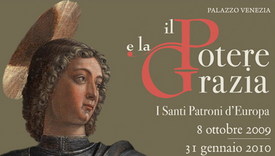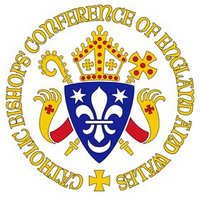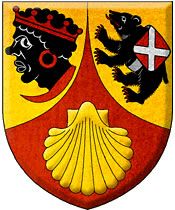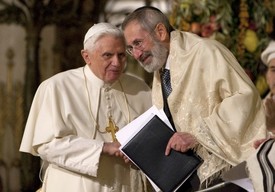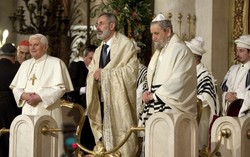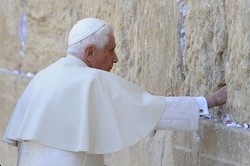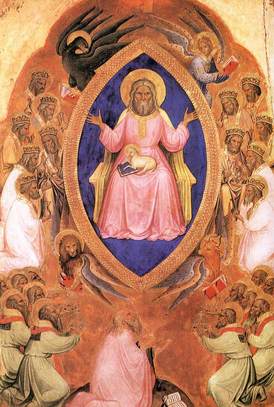Tag: Pope Benedict XVI
Pope tells bishops of England and Wales to be united in teaching the faith and being a witness to Christ
This last week the Pope has meeting individually and collectively with the bishops of England and Wales. As you know, a bishop is obliged to pray at the tombs of Saints Peter and Paul and to offer a review of the pastoral activities of the diocese he leads to the Pope and to his curia. It is a visit to “the threshold” (ad Limina) to the center of our faith. Over the past years the bishops of Britain have faced some serious challenges–much like the bishops of the USA and Canada– and have not responded effectively enough to certain matters of faith and morals. The British bishops are your typical “old boys” network, a closed group of men sitting on their laurels. Generally speaking the UK bishops are not very unified in their teaching the faith which was a hallmark of Cardinal Murphy-O’Connor; one clear indication of this is the work of Bishop O’Donoghue that was posted here calling for clear catechesis, witness and liturgical practice (read two things here and here). In the Pope’s address to the bishops at the end of their to visit Peter, you can see the matters that concern the pope and the Church at large. The papal address at the end of any visit of an episcopal conference is an interesting thing to read because Rome is a bit more objective in reading the tea leaves than those living in situ. General rule of thumb: if it finds its way into print, then it is important to recall. Plus, the Pope is rather subtle in his addresses such that you have to read between the lines. And you may ask why is this text important for North America. Catholics on both sides of the Atlantic face the very same issues when it comes to proposing the faith, moral living, ecumenism and sacramentality. What the Pope told the UK bishops is to be applied in the USA: the old way of doing things has ended. All but 2 paragraphs of the address are given here with my own emphasis on certain points.
I welcome all of you on your ad Limina visit to Rome, where you have come to venerate the tombs of the Apostles Peter and Paul. I thank you for the kind words that Archbishop Vincent Nichols has addressed to me on your behalf, and I offer you my warmest good wishes and prayers for yourselves and all the faithful of England and Wales entrusted to your pastoral care. Your visit to Rome strengthens the bonds of communion between the Catholic community in your country and the Apostolic See, a communion that sustained your people’s faith for centuries, and today provides fresh energies for renewal and evangelization. Even amid the pressures of a secular age, there are many signs of living faith and devotion among the Catholics of England and Wales. I am thinking, for example, of the enthusiasm generated by the visit of the relics of Saint Thérèse, the interest aroused by the prospect of Cardinal Newman’s beatification, and the eagerness of young people to take part in pilgrimages and World Youth Days. On the occasion of my forthcoming Apostolic Visit to Great Britain, I shall be able to witness that faith for myself and, as Successor of Peter, to strengthen and confirm it. During the months of preparation that lie ahead, be sure to encourage the Catholics of England and Wales in their devotion, and assure them that the Pope constantly remembers them in his prayers and holds them in his heart.
Your country is well known for its firm commitment to equality of opportunity for all members of society. Yet as you have rightly pointed out, the effect of some of the legislation designed to achieve this goal has been to impose unjust limitations on the freedom of religious communities to act in accordance with their beliefs. In some respects it actually violates the natural law upon which the equality of all human beings is grounded and by which it is guaranteed. I urge you as Pastors to ensure that the Church’s moral teaching be always presented in its entirety and convincingly defended. Fidelity to the Gospel in no way restricts the freedom of others – on the contrary, it serves their freedom by offering them the truth.
Continue to insist upon your right to participate in national debate through respectful dialogue with other elements in society. In doing so, you are not only maintaining long-standing British traditions of freedom of expression and honest exchange of opinion, but you are actually giving voice to the convictions of many people who lack the means to express them: when so many of the population claim to be Christian, how could anyone dispute the Gospel’s right to be heard?
If the full saving message of Christ is to be presented effectively and convincingly to the world, the Catholic community in your country needs to speak with a united voice. This requires not only you, the Bishops, but also priests, teachers, catechists, writers – in short all who are engaged in the task of communicating the Gospel – to be attentive to the promptings of the Spirit, who guides the whole Church into the truth, gathers her into unity and inspires her with missionary zeal.
Make it your concern, then, to draw on the considerable gifts of the lay faithful in England and Wales and see that they are equipped to hand on the faith to new generations comprehensively, accurately, and with a keen awareness that in so doing they are playing their part in the Church’s mission. In a social milieu that encourages the expression of a variety of opinions on every question that arises, it is important to recognize dissent for what it is, and not to mistake it for a mature contribution to a balanced and wide-ranging debate. It is the truth revealed through Scripture and Tradition and articulated by the Church’s Magisterium that sets us free. Cardinal Newman realized this, and he left us an outstanding example of faithfulness to revealed truth by following that “kindly light” wherever it led him, even at considerable personal cost. Great writers and communicators of his stature and integrity are needed in the Church today, and it is my hope that devotion to him will inspire many to follow in his footsteps.
Much attention has rightly been given to Newman’s scholarship and to his extensive writings, but it is important to remember that he saw himself first and foremost as a priest. In this Annus Sacerdotalis, I urge you to hold up to your priests his example of dedication to prayer, pastoral sensitivity towards the needs of his flock, and passion for preaching the Gospel. You yourselves should set a similar example. Be close to your priests, and rekindle their sense of the enormous privilege and joy of standing among the people of God as alter Christus. In Newman’s words, “Christ’s priests have no priesthood but His … what they do, He does; when they baptize, He is baptizing; when they bless, He is blessing” (Parochial and Plain Sermons, VI 242). Indeed, since the priest plays an irreplaceable role in the life of the Church, spare no effort in encouraging priestly vocations and emphasizing to the faithful the true meaning and necessity of the priesthood. Encourage the lay faithful to express their appreciation of the priests who serve them, and to recognize the difficulties they sometimes face on account of their declining numbers and increasing pressures. The support and understanding of the faithful is particularly necessary when parishes have to be merged or Mass times adjusted. Help them to avoid any temptation to view the clergy as mere functionaries but rather to rejoice in the gift of priestly ministry, a gift that can never be taken for granted.
Ecumenical and inter-religious dialogue assume great importance in England and Wales, given the varied demographic profile of the population. As well as encouraging you in your important work in these areas, I would ask you to be generous in implementing the provisions of the Apostolic Constitution Anglicanorum Coetibus, so as to assist those groups of Anglicans who wish to enter into full communion with the Catholic Church. I am convinced that, if given a warm and open-hearted welcome, such groups will be a blessing for the entire Church.
Pope Benedict’s address at the Great Synagogue of the Jews of Rome
“What marvels the Lord worked for them! What marvels the Lord worked for us: Indeed we were glad” (Ps 126)
“How good and how pleasant it is when brothers live in
unity” (Ps 133)
1. At the beginning of this encounter in the Great Synagogue
of the Jews of Rome, the Psalms which we have heard suggest to us the right
spiritual attitude in which to experience this particular and happy moment of
grace: the praise of the Lord, who has worked marvels for us and has gathered
us in his Hèsed, his merciful love, and thanksgiving to him for granting us
this opportunity to come together to strengthen the bonds which unite us and to
continue to travel together along the path of reconciliation and fraternity. I
wish to express
first of all my sincere gratitude to you, Chief Rabbi, Doctor
Riccardo Di Segni, for your invitation and for the thoughtful words which you
have addressed to me. I wish to thank also the President of the Union of
Italian Jewish Communities, Mr Renzo Gattegna, and the President of the Jewish
Community of Rome, Mr Riccardo Pacifici, for their courteous greetings. My
thoughts go to the Authorities and to all present, and they extend in a special
way, to the entire Jewish Community of Rome and to all who have worked to bring
about this moment of encounter and friendship which we now share.
When he came among you for the first time, as a Christian
and as Pope, my Venerable Predecessor John Paul II, almost 24 years ago, wanted
to make a decisive contribution to strengthening the good relations between our
two communities, so as to overcome every misconception and prejudice. My visit
forms a part of the journey already begun, to confirm and deepen it. With
sentiments of heartfelt appreciation, I come among you to express to you the
esteem and the affection which the Bishop and the Church of Rome, as well as
the entire Catholic Church, have towards this Community and all Jewish
communities around the world.
2. The teaching of the Second Vatican Council has
represented for Catholics a clear landmark to which constant reference is made
in our attitude and our relations with the Jewish people, marking a new and
significant stage. The Council gave a strong impetus to our irrevocable
commitment to pursue the path of dialogue, fraternity and friendship, a journey
which has been deepened and developed in the last forty years, through
important steps and significant gestures. Among them, I should mention once
again the historic visit by my Venerable Predecessor to this Synagogue on 13
April 1986, the numerous meetings he had with Jewish representatives, both here
in Rome and during his Apostolic Visits throughout the world, the Jubilee
Pilgrimage which he made to the Holy Land in the year 2000, the various
documents of the Holy See which, following the Second Vatican Council’s
Declaration Nostra Aetate, have made helpful contributions to the increasingly
close relations between Catholics and Jews. I too, in the course of my
Pontificate, have wanted to demonstrate my closeness to and my affection for
the people of the Covenant. I cherish in my heart each moment of the pilgrimage
that I had the joy of making to the Holy Land in May of last year, along with
the memories of numerous meetings with Jewish Communities and Organizations, in
particular my visits to the Synagogues of Cologne and New York.
Furthermore, the Church has not failed to deplore the
failings of her sons and daughters, begging forgiveness for all that could in
any way have contributed to the scourge of anti-Semitism and anti-Judaism (cf.
Commission for Religious Relations with the Jews, We Remember: A Reflection on
the Shoah, 16 March 1998). May these wounds be healed forever! The heartfelt
prayer which Pope John Paul II offered at the Western Wall on 26 March 2000
comes back to my mind, and it calls forth a profound echo in our hearts:
“God of our Fathers, you chose Abraham and his descendants to bring your
Name to the nations: we are deeply saddened by the behaviour of those who in
the course of history have caused these children of yours to suffer, and asking
your forgiveness we wish to commit ourselves to genuine brotherhood with the
people of the Covenant.”
3. The passage of time allows us to recognize in the
Twentieth Century a truly tragic period for humanity: ferocious wars that sowed
destruction, death and suffering like never before; frightening ideologies,
rooted in the idolatry of man, of race, and of the State, which led to brother
killing brother. The singular and deeply disturbing drama of the Shoah
represents, as it were, the most extreme point on the path of hatred that
begins when man forgets his Creator and places himself at the centre of the
universe. As I noted during my visit of 28 May 2006 to the Auschwitz
Concentration camp, which is still profoundly impressed upon my memory,
“the rulers of the Third Reich wanted to crush the entire Jewish
people”, and, essentially, “by wiping out this people, they intended
to kill the God who called Abraham, who spoke on Sinai and laid down principles
to serve as a guide for mankind, principles that remain eternally valid”
(Discourse at Auschwitz-Birkenau Concentration Camp: The Teachings of Pope
Benedict XVI, II, 1 [2006], p.727).
Here in this place, how could we not remember the Roman Jews
who were snatched from their homes, before these very walls, and who with
tremendous brutality were killed at Auschwitz? How could one ever forget their
faces, their names, their tears, the desperation faced by these men, women and
children? The extermination of the people of the Covenant of Moses, at first
announced, then systematically programmed and put into practice in Europe under
the Nazi regime, on that day tragically reached as far as Rome. Unfortunately,
many remained indifferent, but many, including Italian Catholics, sustained by
their faith and by Christian teaching, reacted with courage, often at risk of
their lives, opening their arms to assist the Jewish fugitives who were being
hunted down, and earning perennial gratitude. The Apostolic See itself provided
assistance, often in a hidden and discreet way.
The memory of these events compels us to strengthen the
bonds that unite us so that our mutual understanding, respect and acceptance
may always increase.
4. Our closeness and spiritual fraternity find in the Holy
Bible – in Hebrew Sifre Qodesh or “Book of Holiness” – their most
stable and lasting foundation, which constantly reminds us of our common roots,
our history and the rich spiritual patrimony that we share. It is in pondering
her own mystery that the Church, the People of God of the New Covenant,
discovers her own profound bond with the Jews, who were chosen by the Lord
before all others to receive his word (cf. Catechism of the Catholic Church,
839). “The Jewish faith, unlike other non-Christian religions, is already
a response to God’s revelation in the Old Covenant. To the Jews ‘belong the
sonship, the glory, the covenants, the giving of the law, the worship, and the promises;
to them belong the patriarchs and of their race, according to the flesh is the
Christ’ (Rom 9:4-5), ‘for the gifts and the call of God are irrevocable!’ (Rom
11:29)” (Ibid).
5. Many lessons may be learnt from our common heritage
derived from the Law and the Prophets. I would like to recall some of them:
first of all, the solidarity which binds the Church to the Jewish people
“at the level of their spiritual identity“, which offers Christians
the opportunity to promote “a renewed respect for the Jewish interpretation
of the Old Testament” (cf. Pontifical Biblical Commission, The Jewish
people and their Sacred Scriptures in the Christian Bible, 2001, pp.12 and 55);
the centrality of the Decalogue as a common ethical message of permanent value
for Israel, for the Church, for non-believers and for all of humanity; the task
of preparing or ushering in the Kingdom of the Most High in the “care for
creation” entrusted by God to man for him to cultivate and to care for
responsibly (cf. Gen 2:15).
6. In particular, the Decalogue – the “Ten Words”
or Ten Commandments (cf. Ex 20:1-17; Dt 5:1-21) – which comes from the Torah of
Moses, is a shining light for ethical principles, hope and dialogue, a guiding
star of faith and morals for the people of God, and it also enlightens and
guides the path of Christians. It constitutes a beacon and a norm of life in
justice and love, a “great ethical code” for all humanity. The
“Ten Commandments” shed light on good and evil, on truth and
falsehood, on justice and injustice, and they match the criteria of every human
person’s right conscience. Jesus himself recalled this frequently, underlining
the need for active commitment in living the way of the Commandments: “If
you wish to enter into life, observe the Commandments” (Mt 19:17). From
this perspective, there are several possible areas of cooperation and witness.
I would like to recall three that are especially important for our time.
The “Ten Commandments” require that we recognize
the one Lord, against the temptation to construct other idols, to make golden
calves. In our world there are many who do not know God or who consider him
superfluous, without relevance for their lives; hence, other new gods have been
fabricated to whom man bows down. Reawakening in our society openness to the
transcendent dimension, witnessing to the one God, is a precious service which
Jews and Christians can offer together.
The “Ten Commandments” call us to respect life and
to protect it against every injustice and abuse, recognizing the worth of each
human person, created in the image and likeness of God. How often, in every
part of the world, near and far, the dignity, the freedom and the rights of
human beings are trampled upon! Bearing witness together to the supreme value
of life against all selfishness, is an important contribution to a new world
where justice and peace reign, a world marked by that “shalom” which
the lawgivers, the prophets and the sages of Israel longed to see.
The “Ten Commandments” call us to preserve and to
promote the sanctity of the family, in which the personal and reciprocal,
faithful and definitive “Yes” of man and woman makes room for the
future, for the authentic humanity of each, and makes them open, at the same
time, to the gift of new life. To witness that the family continues to be the
essential cell of society and the basic environment in which human virtues are
learned and practised is a precious service offered in the construction of a
world with a more human face.
7. As Moses taught in the Shema (cf. Dt 6:5; Lev 19:34) –
and as Jesus reaffirms in the Gospel (cf. Mk 12:19-31), all of the Commandments
are summed up in the love of God and loving-kindness towards one’s neighbour.
This Rule urges Jews and Christians to exercise, in our time, a special
generosity towards the poor, towards women and children, strangers, the sick,
the weak and the needy. In the Jewish tradition there is a wonderful saying of
the Fathers of Israel: “Simon the Just often said: The world is founded on
three things: the Torah, worship, and acts of mercy” (Avoth 1:2). In
exercising justice and mercy, Jews and Christians are called to announce and to
bear witness to the coming Kingdom of the Most High, for which we pray and work
in hope each day.
8. On this path we can walk together, aware of the
differences that exist between us, but also aware of the fact that when we
succeed in uniting our hearts and our hands in response to the Lord’s call, his
light comes closer and shines on all the peoples of the world. The progress
made in the last forty years by the International Committee for Catholic-Jewish
Relations and, in more recent years, by the Mixed Commission of the Chief
Rabbinate of Israel and of the Holy See, are a sign of our common will to
continue an open and sincere dialogue. Tomorrow here in Rome, in fact, the
Mixed Commission will hold its ninth meeting, on “Catholic and Jewish
Teaching on Creation and the Environment”; we wish them a profitable
dialogue on such a timely and important theme.
9. Christians and Jews share to a great extent a common
spiritual patrimony, they pray to the same Lord, they have the same roots, and
yet they often remain unknown to each other. It is our duty, in response to
God’s call, to strive to keep open the space for dialogue, for reciprocal
respect, for growth in friendship, for a common witness in the face of the
challenges of our time, which invite us to cooperate for the good of humanity
in this world created by God, the Omnipotent and Merciful.
10. Finally, I offer a particular reflection on this, our
city of Rome, where, for nearly two millennia, as Pope John Paul II said, the
Catholic Community with its Bishop and the Jewish Community with its Chief
Rabbi have lived side by side. May this proximity be animated by a growing
fraternal love, expressed also in closer cooperation, so that we may offer a
valid contribution to solving the problems and difficulties that we still face.
I beg from the Lord the precious gift of peace in the world,
above all in the Holy Land. During my pilgrimage there last May, at the Western
Wall in Jerusalem, I prayed to Him who can do all things, asking: “Send
your peace upon this Holy Land, upon the Middle East, upon the entire human
family; stir the hearts of those who call upon your name, to walk humbly in the
path of justice and compassion” (Prayer at the Western Wall of Jerusalem,
12 May 2009).
I give thanks and praise to God once again for this
encounter, asking him to strengthen our fraternal bonds and to deepen our
mutual understanding.
“O praise the Lord, all you nations, acclaim him, all you peoples. Strong is his love for us, He is faithful forever. Alleluia” (Ps 117)
Benedict meets an admirer, Susanna Maiolo
At the end of the general audience today, Pope Benedict met privately, for a brief time, with Susanna Maiolo and 2 members of her family. You’ll recall the unpleasant incident of Ms Maiolo taking down the pope and a cardinal. Ms. Maiolo expressed her regret for what happened at the celebration of the night Mass for Christmas at St Peter’s Basilica, and for his part, the Holy Father gave her his forgiveness and expressed good wishes.
Benedict’s 2009 Christmas message to the world
Lux fulgebit hodie super nos, quia natus est nobis Dominus.
(A light will shine on us this day, the Lord is born for us.)
(Roman Missal, Christmas, Entrance Antiphon for the Mass at Dawn)
The liturgy of the Mass at Dawn reminded us that the night is now past, the day has begun; the light radiating from the cave of Bethlehem shines upon us.
The Bible and the Liturgy do not, however, speak to us about a natural light, but a different, special light, which is somehow directed to and focused upon “us”, the same “us” for whom the Child of Bethlehem “is born”. This “us” is the Church, the great universal family of those who believe in Christ, who have awaited in hope the new birth of the Savior, and who today celebrate in mystery the perennial significance of this event.
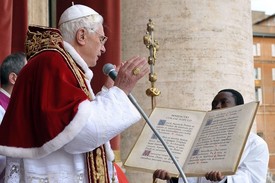 At first, beside the manger in Bethlehem, that “us” was almost imperceptible to human eyes. As the Gospel of Saint Luke recounts, it included, in addition to Mary and Joseph, a few lowly shepherds who came to the cave after hearing the message of the Angels. The light of that first Christmas was like a fire kindled in the night. All about there was darkness, while in the cave there shone the true light “that enlightens every man” (Jn 1:9). And yet all this took place in simplicity and hiddenness, in the way that God works in all of salvation history. God loves to light little lights, so as then to illuminate vast spaces. Truth, and Love, which are its content, are kindled wherever the light is welcomed; they then radiate in concentric circles, as if by contact, in the hearts and minds of all those who, by opening themselves freely to its splendour, themselves become sources of light. Such is the history of the Church: she began her journey in the lowly cave of Bethlehem, and down the centuries she has become a People and a source of light for humanity. Today too, in those who encounter that Child, God still kindles fires in the night of the world, calling men and women everywhere to acknowledge in Jesus the “sign” of his saving and liberating presence and to extend the “us” of those who believe in Christ to the whole of mankind.
At first, beside the manger in Bethlehem, that “us” was almost imperceptible to human eyes. As the Gospel of Saint Luke recounts, it included, in addition to Mary and Joseph, a few lowly shepherds who came to the cave after hearing the message of the Angels. The light of that first Christmas was like a fire kindled in the night. All about there was darkness, while in the cave there shone the true light “that enlightens every man” (Jn 1:9). And yet all this took place in simplicity and hiddenness, in the way that God works in all of salvation history. God loves to light little lights, so as then to illuminate vast spaces. Truth, and Love, which are its content, are kindled wherever the light is welcomed; they then radiate in concentric circles, as if by contact, in the hearts and minds of all those who, by opening themselves freely to its splendour, themselves become sources of light. Such is the history of the Church: she began her journey in the lowly cave of Bethlehem, and down the centuries she has become a People and a source of light for humanity. Today too, in those who encounter that Child, God still kindles fires in the night of the world, calling men and women everywhere to acknowledge in Jesus the “sign” of his saving and liberating presence and to extend the “us” of those who believe in Christ to the whole of mankind.
Wherever there is an “us” which welcomes God’s love, there the light of Christ shines forth, even in the most difficult situations. The Church, like the Virgin Mary, offers the world Jesus, the Son, whom she herself has received as a gift, the One who came to set mankind free from the slavery of sin. Like Mary, the Church does not fear, for that Child is her strength. But she does not keep him for herself: she offers him to all those who seek him with a sincere heart, to the earth’s lowly and afflicted, to the victims of violence, and to all who yearn for peace. Today too, on behalf of a human family profoundly affected by a grave financial crisis, yet even more by a moral crisis, and by the painful wounds of wars and conflicts, the Church, in faithful solidarity with mankind, repeats with the shepherds: “Let us go to Bethlehem” (Lk 2:15), for there we shall find our hope.
The “us” of the Church is alive in the place where Jesus was born, in the Holy Land, inviting its people to abandon every logic of violence and vengeance, and to engage with renewed vigour and generosity in the process which leads to peaceful coexistence. The “us” of the Church is present in the other countries of the Middle East. How can we forget the troubled situation in Iraq and the “little flock” of Christians which lives in the region? At times it is subject to violence and injustice, but it remains determined to make its own contribution to the building of a society opposed to the logic of conflict and the rejection of one’s neighbour. The “us” of the Church is active in Sri Lanka, in the Korean peninsula and in the Philippines, as well as in the other countries of Asia, as a leaven of reconciliation and peace. On the continent of Africa she does not cease to lift her voice to God, imploring an end to every injustice in the Democratic Republic of Congo; she invites the citizens of Guinea and Niger to respect for the rights of every person and to dialogue; she begs those of Madagascar to overcome their internal divisions and to be mutually accepting; and she reminds all men and women that they are called to hope, despite the tragedies, trials and difficulties which still afflict them. In Europe and North America, the “us” of the Church urges people to leave behind the selfish and technicist mentality, to advance the common good and to show respect for the persons who are most defenceless, starting with the unborn. In Honduras she is assisting in process of rebuilding institutions; throughout Latin America, the “us” of the Church is a source of identity, a fullness of truth and of charity which no ideology can replace, a summons to respect for the inalienable rights of each person and his or her integral development, a proclamation of justice and fraternity, a source of unity.
In fidelity to the mandate of her Founder, the Church shows solidarity with the victims of natural disasters and poverty, even within opulent societies. In the face of the exodus of all those who migrate from their homelands and are driven away by hunger, intolerance or environmental degradation, the Church is a presence calling others to an attitude of acceptance and welcome. In a word, the Church everywhere proclaims the Gospel of Christ, despite persecutions, discriminations, attacks and at times hostile indifference. These, in fact, enable her to share the lot of her Master and Lord.
Dear Brothers and Sisters, how great a gift it is to be part of a communion which is open to everyone! It is the communion of the Most Holy Trinity, from whose heart Emmanuel, Jesus, “God with us”, came into the world. Like the shepherds of Bethlehem, let us contemplate, filled with wonder and gratitude, this mystery of love and light! Happy Christmas to all!
Benedictus PP XVI, Christmas 2009
The search for God of all people, believers and non-believers concerns us, Pope said
The Holy Father’s annual address to the Roman Curia -the
Cardinals and bishops resident in Rome and other officials of the Roman Curia who assist him in
his governance of the Universal Church– took place yesterday. In it the Pope points to some notable concerns that he thinks that ought to be the concern of all
of us who believe faith is central our lives. Namely, belief and unbelief,
doubt and certainty and freedom with regard to God and humanity’s search for God. In my humble opinion, this papal address should be an essential point in any diocesan, parish or ecclesial movement’s pastoral plan in 2010 and beyond. In part the Holy Father said,
people who describe themselves as agnostics or atheists must be very important
to us as believers. When we talk about a new evangelization, these people may
become afraid. They do not want to see themselves as an object of mission, nor
do they want to renounce their freedom of thought or of will. But the question
about God nonetheless remains present for them as well, even if they cannot
believe in the concrete nature of his attention to us.
about the search for God as the fundamental motive from which Western
monasticism was born, and with it, Western culture. As the first step in
evangelization, we must try to keep this search alive; we must take pains that
man not set aside the question of God as an essential question of his
existence. Take pains that he accept this question and the longing concealed
within it.
Isaiah, that the temple should be a house of prayer for all peoples (cf. Isaiah
56:7; Mark 11:17). He was thinking about what was called the court of the
gentiles, which he cleansed of extraneous business so that it could be the
space available for the gentiles who wanted to pray to the one God there, even
if they could not take part in the mystery, for service of which the interior
of the temple was reserved.
meant the people who know God, so to speak, only from afar; who are
dissatisfied with their gods, rites, myths; who desire the Pure and the Great,
even if God remains for them the “unknown God” (cf. Acts 17:23). They
needed to be able to pray to the unknown God, and so be in relation with the
true God, although in the midst of obscurities of various kinds.
the Church should also open today a sort of “court of the gentiles”
where men can in some manner cling to God, without knowing him and before they
have found the entryway to his mystery, which the interior life of the Church
serves. To the dialogue with the religions it must above all add today a
dialogue with those for whom religion is something foreign, to whom God is
unknown, and who nonetheless would not like simply to remain without God, but
at least to approach him as the Unknown.
God Today: With Him or Without Him Everything Changes
Almost two weeks ago Pope Benedict sent a message to the president of the Italian Bishops’ Conference, Angelo Cardinal Bagnasco, who is chairing a meeting where the agenda is talking about God, of all things. Well, it beats talking about bishops, nuns and the environment all the time. This topic interests me not in the sense of mere curiosity but because it is taking seriously my seeking the face of God (this topic ought to concern all people who consider themselves Catholic, spiritual and/or religious). To say God interests me sounds like an academic exercise; it is and it is not entirely that. God is interesting to me because seeking God is like no other search I know of, for it concerns my entire self and it intersects all that I do in the world. Is God totally unknowable, the Mystery and desirous of a personal relationship with me (and you)? The Pope makes some great points in these few paragraphs. The curious points are emphasized below.
On the occasion of the Congress “God Today: With or
Without Him Everything Changes,” which is taking place in Rome from
December 10-12, I wish to express to you, venerated Brother, to the Italian
Episcopal Conference and, in particular, to the Committee for the Cultural
Project, my profound appreciation for this important initiative, which
addresses one of the great topics that has always fascinated and questioned the
human spirit.
The question of God is also central in our time, in which man is
often reduced to one dimension, the “horizontal,” considering
openness to the Transcendent as irrelevant for his life. The relationship with
God, instead, is essential for humanity’s journey and, as I have had the
occasion to affirm many times, the Church and every Christian, in fact, have
the task to make God present in this world, to attempt to open to men access to
God.
Planned from this perspective is the international event of these days.
The breadth of the approach to the important topic that characterizes the
meeting, will make possible the sketching of a rich and articulated picture of
the question of God, but above all it will be a stimulation for a profound
reflection on God’s place in the culture and life of our time.
On one hand, in
fact, an attempt is being made to show the different ways that lead to
affirming the truth about the existence of God, that God which humanity has
always known in some way, even in the chiaroscuro of his history, and who
revealed himself with the splendor of his face in the covenant with the people
of Israel and, beyond that, in every measure and hope, in a full and definitive
way, in Jesus Christ.
He is the Son of God, the Living who enters into the life
and history of man to illumine him with his grace, with his presence. On the
other hand, the desire is precisely to bring to light the essential importance
that God has for us, for our personal and social life, for understanding
ourselves and the world, for the hope that illumines our way, for the salvation
that awaits us beyond death.
Directed to these objectives are the numerous
interventions, according to the many points of view which will be the object of
study and exchange: from philosophical and theological reflection on the
witness of the great religions; from the impulse to God, which finds its
expression in music, literature, the figurative arts, the cinema and
television; to the development of the sciences, which attempt to read in depth
the mechanisms of nature, fruit of the intelligent work of God the Creator; from
the analysis of the personal experience of God to the consideration of the
social and political dynamics of an already globalized world.
In a cultural and
spiritual situation such as the one we are living in, where the tendency grows
to relegate God to the private sphere, to consider him irrelevant and
superfluous, or to reject him explicitly, it is my heartfelt hope that this
event might at least contribute to disperse that semi-darkness that makes
openness to God precarious and fearful for the men of our time, though he never
ceases to knock on our door.
The experiences of the past, although not remote
to us, teach us that when God disappears from man’s horizon, humanity loses its
direction and runs the risk of taking steps to its own destruction. Faith in
God opens man to the horizon of certain hope, which does not disappoint; it
indicates a solid foundation on which to base life without fear; it calls for
abandoning oneself with confidence in the hands of the Love which sustains the
world.
To you, cardinal, to all those who have contributed to prepare this
congress, to the speakers and to all the participants I express my cordial
greeting with the desire for the full success of the initiative. I support the
works with prayer and with my apostolic blessing, propitiator of that light
from on High, which makes us capable of finding God, our treasure and our hope.
Pope calls for prayers and care for those living with HIV/AIDS
This coming December 1 the World AIDS Day will be
observed. My thought and my prayer go to all persons affected by this sickness,
in particular children, to the poorest and to those who are rejected. The
Church does not cease to combat AIDS, through her institutions and the
personnel dedicated to it. I exhort everyone to make their own contribution
with prayer and care, so that those who are affected by the HIV virus will feel
the presence of the Lord who gives support and hope. Finally, I hope that, by
multiplying and coordinating efforts, this sickness will be halted and
eradicated.
Beauty befits our destiny: Pope Benedict reflects the absolute need for beauty in our lives
With great joy I welcome you to this solemn place, so rich in art and in history. I cordially greet each and every one of you and I thank you for accepting my invitation. At this gathering I wish to express and renew the Church’s friendship with the world of art, a friendship that has been strengthened over time; indeed Christianity from its earliest days has recognized the value of the arts and has made wise use of their varied language to express her unvarying message of salvation. This friendship must be continually promoted and supported so that it may be authentic and fruitful, adapted to different historical periods and attentive to social and cultural variations. Indeed, this is the reason for our meeting here today. I am deeply grateful to Archbishop Gianfranco Ravasi, President of the Pontifical Council for Culture and of the Pontifical Commission for the Cultural Patrimony of the Church, and likewise to his officials, for promoting and organizing this meeting, and I thank him for the words he has just addressed to me. I greet the Cardinals, the Bishops, the priests and the various distinguished personalities present. I also thank the Sistine Chapel Choir for their contribution to this gathering. Today’s event is focused on you, dear and illustrious artists, from different countries, cultures and religions, some of you perhaps remote from the practice of religion, but interested nevertheless in maintaining communication with the Catholic Church, in not reducing the horizons of existence to mere material realities, to a reductive and trivializing vision. You represent the varied world of the arts and so, through you, I would like to convey to all artists my invitation to friendship, dialogue and cooperation.
Some significant anniversaries occur around this time. It is ten years since the Letter to Artists by my venerable Predecessor, the Servant of 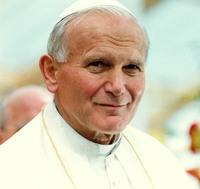 God Pope John Paul II. For the first time, on the eve of the Great Jubilee of the Year 2000, the Pope, who was an artist himself, wrote a Letter to artists, combining the solemnity of a pontifical document with the friendly tone of a conversation among all who, as we read in the initial salutation, “are passionately dedicated to the search for new ‘epiphanies’ of beauty”. Twenty-five years ago the same Pope proclaimed Blessed Fra Angelico the patron of artists, presenting him as a model of perfect harmony between faith and art. I also recall how on
God Pope John Paul II. For the first time, on the eve of the Great Jubilee of the Year 2000, the Pope, who was an artist himself, wrote a Letter to artists, combining the solemnity of a pontifical document with the friendly tone of a conversation among all who, as we read in the initial salutation, “are passionately dedicated to the search for new ‘epiphanies’ of beauty”. Twenty-five years ago the same Pope proclaimed Blessed Fra Angelico the patron of artists, presenting him as a model of perfect harmony between faith and art. I also recall how on 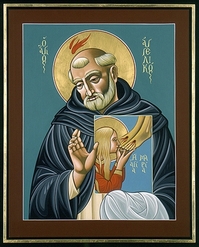 the express wish of Pope Paul VI, to confirm the friendship between the Church and the arts. The words that he spoke on that occasion resound once more today under the vault of the Sistine Chapel and touch our hearts and our minds. “We need you,” he said. “We need your collaboration in order to carry out our ministry, which consists, as you know, in preaching and rendering accessible and comprehensible to the minds and hearts of our people the things of the spirit, the invisible, the ineffable, the things of God himself. And in this activity … you are masters. It is your task, your mission, and your art consists in grasping treasures from the heavenly realm of the spirit and clothing them in words, colours, forms – making them accessible.” So great was Paul VI‘s esteem for artists that he was moved to use daring expressions. “And if we were deprived of your assistance,” he added, “our ministry would become faltering and uncertain, and a special effort would be needed, one might say, to make it artistic, even prophetic. In order to scale the heights of lyrical expression of intuitive beauty, priesthood would have to coincide with art.” On that occasion Paul VI made a commitment to “re-establish the friendship between the Church and artists”, and he invited artists to make a similar, shared commitment, analyzing seriously and objectively the factors that disturbed this relationship, and assuming individual responsibility, courageously and passionately, for a newer and deeper journey in mutual acquaintance and dialogue in order to arrive at an authentic “renaissance” of art in the context of a new humanism.
the express wish of Pope Paul VI, to confirm the friendship between the Church and the arts. The words that he spoke on that occasion resound once more today under the vault of the Sistine Chapel and touch our hearts and our minds. “We need you,” he said. “We need your collaboration in order to carry out our ministry, which consists, as you know, in preaching and rendering accessible and comprehensible to the minds and hearts of our people the things of the spirit, the invisible, the ineffable, the things of God himself. And in this activity … you are masters. It is your task, your mission, and your art consists in grasping treasures from the heavenly realm of the spirit and clothing them in words, colours, forms – making them accessible.” So great was Paul VI‘s esteem for artists that he was moved to use daring expressions. “And if we were deprived of your assistance,” he added, “our ministry would become faltering and uncertain, and a special effort would be needed, one might say, to make it artistic, even prophetic. In order to scale the heights of lyrical expression of intuitive beauty, priesthood would have to coincide with art.” On that occasion Paul VI made a commitment to “re-establish the friendship between the Church and artists”, and he invited artists to make a similar, shared commitment, analyzing seriously and objectively the factors that disturbed this relationship, and assuming individual responsibility, courageously and passionately, for a newer and deeper journey in mutual acquaintance and dialogue in order to arrive at an authentic “renaissance” of art in the context of a new humanism.
That historic encounter, as I mentioned, took place here in this sanctuary of faith and human creativity. So it is not by chance that we come together in this place, esteemed for its architecture and its symbolism, and above all for the frescoes that make it unique, from the masterpieces of Perugino and Botticelli, Ghirlandaio and Cosimo Rosselli, Luca Signorelli and others, to the Genesis scenes and the Last Judgement of Michelangelo Buonarroti, who has given us here one of the most extraordinary creations in the entire history of art. The universal language of music has often been heard here, thanks to the genius of great musicians who have placed their art at the service of the liturgy, assisting the spirit in its ascent towards God. At the same time, the Sistine Chapel is remarkably vibrant with history, since it is the solemn and austere setting of events that mark the history of the Church and of mankind. Here as you know, the College of Cardinals elects the Pope; here it was that I myself, with trepidation but also with absolute trust in the Lord, experienced the privileged moment of my election as Successor of the Apostle Peter.
Dear friends, let us allow these frescoes to speak to us today, drawing us towards the ultimate goal of human history. The Last Judgement, which you see behind me, reminds us that human history is movement and ascent, a continuing tension towards fullness, towards human happiness, towards a horizon that always transcends the present moment even as the two coincide. Yet the dramatic scene portrayed in this fresco also places before our eyes the risk of man’s definitive fall, a risk that threatens to engulf him whenever he allows himself to be led astray by the forces of evil. So the fresco issues a strong prophetic cry against evil, against every form of injustice. For believers, though, the Risen Christ is the Way, the Truth and the Life. For his faithful followers, he is the Door through which we are brought to that “face-to-face” vision of God from which limitless, full and definitive happiness flows. Thus Michelangelo presents to our gaze the Alpha and the Omega, the Beginning and the End of history, and he invites us to walk the path of life with joy, courage and hope. The dramatic beauty of Michelangelo’s painting, its colours and forms, becomes a proclamation of hope, an invitation to raise our gaze to the ultimate horizon. The profound bond between beauty and hope was the essential content of the evocative  Message that Paul VI addressed to artists at the conclusion of the Second Vatican Ecumenical Council on 8 December 1965: “To all of you,” he proclaimed solemnly, “the Church of the Council declares through our lips: if you are friends of true art, you are our friends!” And he added: “This world in which we live needs beauty in order not to sink into despair. Beauty, like truth, brings joy to the human heart, and is that precious fruit which resists the erosion of time, which unites generations and enables them to be one in admiration. And all this through the work of your hands . . . Remember that you are the custodians of beauty in the world.”
Message that Paul VI addressed to artists at the conclusion of the Second Vatican Ecumenical Council on 8 December 1965: “To all of you,” he proclaimed solemnly, “the Church of the Council declares through our lips: if you are friends of true art, you are our friends!” And he added: “This world in which we live needs beauty in order not to sink into despair. Beauty, like truth, brings joy to the human heart, and is that precious fruit which resists the erosion of time, which unites generations and enables them to be one in admiration. And all this through the work of your hands . . . Remember that you are the custodians of beauty in the world.”
Unfortunately, the present time is marked, not only by negative elements in the social and economic sphere, but also by a weakening of hope, by a certain lack of confidence in human relationships, which gives rise to increasing signs of resignation, aggression and despair. The world in which we live runs the risk of being altered beyond recognition because of unwise human actions which, instead of cultivating its beauty, unscrupulously exploit its resources for the advantage of a few and not infrequently disfigure the marvels of nature. What is capable of restoring enthusiasm and confidence, what can encourage the human spirit to rediscover its path, to raise its eyes to the horizon, to dream of a life worthy of its vocation – if not beauty? Dear friends, as artists you know well that the experience of beauty, beauty that is authentic, not merely transient or artificial, is by no means a supplementary or secondary factor in our search for meaning and happiness; the experience of beauty does not remove us from reality, on the contrary, it leads to a direct encounter with the daily reality of our lives, liberating it from darkness, transfiguring it, making it radiant and beautiful.
Indeed, an essential function of genuine beauty, as emphasized by Plato, is that it gives man a healthy “shock”, it draws him out of himself, wrenches him away from resignation and from being content with the humdrum – it even makes him suffer, piercing him like a dart, but in so doing it “reawakens” him, opening afresh the eyes of his heart and mind, giving him wings, carrying him aloft. Dostoevsky’s words that I am about to quote are bold and paradoxical, but they invite reflection. He says this: “Man can live without science, he can live without bread, but without beauty he could no longer live, because there would no longer be anything to do to the world. The whole secret is here, the whole of history is here.” The painter Georges Braque echoes this sentiment: “Art is meant to disturb, science reassures.” Beauty pulls us up short, but in so doing it reminds us of our final destiny, it sets us back on our path, fills us with new hope, gives us the courage to live to the full the unique gift of life. The quest for beauty that I am describing here is clearly not about escaping into the irrational or into mere aestheticism.
Too often, though, the beauty that is thrust upon us is illusory and deceitful, superficial and blinding, leaving the onlooker dazed; instead of bringing him out of himself and opening him up to horizons of true freedom as it draws him aloft, it imprisons him within himself and further enslaves him, depriving him of hope and joy. It is a seductive but hypocritical beauty that rekindles desire, the will to power, to possess, and to dominate others, it is a beauty which soon turns into its opposite, taking on the guise of indecency, transgression or gratuitous provocation. Authentic beauty, however, unlocks the yearning of the human heart, the profound desire to know, to love, to go towards the Other, to reach for the Beyond. If we acknowledge that beauty touches us intimately, that it wounds us, that it opens our eyes, then we rediscover the joy of seeing, of being able to grasp the profound meaning of our existence, the Mystery of which we are part; from this Mystery we can draw fullness, happiness, the passion to engage with it every day. In this regard, Pope John Paul II, in his Letter to Artists, quotes the following verse from a Polish poet, Cyprian Norwid: “Beauty is to enthuse us for work, and work is to raise us up” (no. 3). And later he adds: “In so far as it seeks the beautiful, fruit of an imagination which rises above the everyday, art is by its nature a kind of appeal to the mystery. Even when they explore the darkest depths of the soul or the most unsettling aspects of evil, the artist gives voice in a way to the universal desire for redemption” (no. 10). And in conclusion he states: “Beauty is a key to the mystery and a call to transcendence” (no. 16).
These ideas impel us to take a further step in our reflection. Beauty, whether that of the natural universe or that expressed in art, precisely because it opens up and broadens the horizons of human awareness, pointing us beyond ourselves, bringing us face to face with the abyss of Infinity, can become a path towards the transcendent, towards the ultimate Mystery, towards God. Art, in all its forms, at the point where it encounters the great questions of our existence, the fundamental themes that give life its meaning, can take on a religious quality, thereby turning into a path of profound inner reflection and spirituality. This close proximity, this harmony between the journey of faith and the artist’s path is attested by countless artworks that are based upon the personalities, the stories, the symbols of that immense deposit of “figures” – in the broad sense – namely the Bible, the Sacred Scriptures. The great biblical narratives, themes, images and parables have inspired innumerable masterpieces in every sector of the arts, just as they have spoken to the hearts of believers in every generation through the works of craftsmanship and folk art, that are no less eloquent and evocative.
In this regard, one may speak of a via pulchritudinis, a path of beauty which is at the same time an artistic and aesthetic journey, a journey of faith, of theological enquiry. The theologian Hans Urs von Balthasar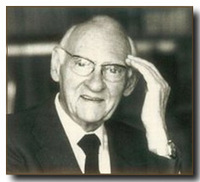 begins his great work entitled The Glory of the Lord – a Theological Aesthetics with these telling observations: “Beauty is the word with which we shall begin. Beauty is the last word that the thinking intellect dares to speak, because it simply forms a halo, an untouchable crown around the double constellation of the true and the good and their inseparable relation to one another.” He then adds: “Beauty is the disinterested one, without which the ancient world refused to understand itself, a word which both imperceptibly and yet unmistakably has bid farewell to our new world, a world of interests, leaving it to its own avarice and sadness. It is no longer loved or fostered even by religion.” And he concludes: “We can be sure that whoever sneers at her name as if she were the ornament of a bourgeois past – whether he admits it or not – can no longer pray and soon will no longer be able to love.” The way of beauty leads us, then, to grasp the Whole in the fragment, the Infinite in the finite, God in the history of humanity.
begins his great work entitled The Glory of the Lord – a Theological Aesthetics with these telling observations: “Beauty is the word with which we shall begin. Beauty is the last word that the thinking intellect dares to speak, because it simply forms a halo, an untouchable crown around the double constellation of the true and the good and their inseparable relation to one another.” He then adds: “Beauty is the disinterested one, without which the ancient world refused to understand itself, a word which both imperceptibly and yet unmistakably has bid farewell to our new world, a world of interests, leaving it to its own avarice and sadness. It is no longer loved or fostered even by religion.” And he concludes: “We can be sure that whoever sneers at her name as if she were the ornament of a bourgeois past – whether he admits it or not – can no longer pray and soon will no longer be able to love.” The way of beauty leads us, then, to grasp the Whole in the fragment, the Infinite in the finite, God in the history of humanity. 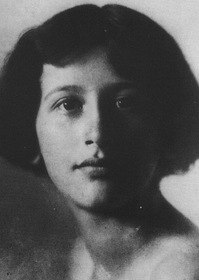 Simone Weil wrote in this regard: “In all that awakens within us the pure and authentic sentiment of beauty, there, truly, is the presence of God. There is a kind of incarnation of God in the world, of which beauty is the sign. Beauty is the experimental proof that incarnation is possible. For this reason all art of the first order is, by its nature, religious.” Hermann Hesse makes the point even more graphically: “Art means: revealing God in everything that exists.” Echoing the words of Pope Paul VI, the Servant of God Pope John Paul II restated the Church’s desire to renew dialogue and cooperation with artists: “In order to communicate the message entrusted to her by Christ, the Church needs art” (no. 12); but he immediately went on to ask: “Does art need the Church?” – thereby inviting artists to rediscover a source of fresh and well-founded inspiration in religious experience, in Christian revelation and in the “great codex” that is the Bible.
Simone Weil wrote in this regard: “In all that awakens within us the pure and authentic sentiment of beauty, there, truly, is the presence of God. There is a kind of incarnation of God in the world, of which beauty is the sign. Beauty is the experimental proof that incarnation is possible. For this reason all art of the first order is, by its nature, religious.” Hermann Hesse makes the point even more graphically: “Art means: revealing God in everything that exists.” Echoing the words of Pope Paul VI, the Servant of God Pope John Paul II restated the Church’s desire to renew dialogue and cooperation with artists: “In order to communicate the message entrusted to her by Christ, the Church needs art” (no. 12); but he immediately went on to ask: “Does art need the Church?” – thereby inviting artists to rediscover a source of fresh and well-founded inspiration in religious experience, in Christian revelation and in the “great codex” that is the Bible.
Dear artists, as I draw to a conclusion, I too would like to make a cordial, friendly and impassioned appeal to you, as did my Predecessor. You are the custodians of beauty: thanks to your talent, you have the opportunity to speak to the heart of humanity, to touch individual and collective sensibilities, to call forth dreams and hopes, to broaden the horizons of knowledge and of human engagement. Be grateful, then, for the gifts you have received and be fully conscious of your great responsibility to communicate beauty, to communicate in and through beauty! Through your art, you yourselves are to be heralds and witnesses of hope for humanity! And do not be afraid to approach the first and last source of beauty, to enter into dialogue with believers, with those who, like yourselves, consider that they are pilgrims in this world and in history towards infinite Beauty! Faith takes nothing away from your genius or your art: on the contrary, it exalts them and nourishes them, it encourages them to cross the threshold and to contemplate with fascination and emotion the ultimate and definitive goal, the sun that does not set, the sun that illumines this present moment and makes it beautiful.
 Saint Augustine, who fell in love with beauty and sang its praises, wrote these words as he reflected on man’s ultimate destiny, commenting almost ante litteram on the Judgement scene before your eyes today: “Therefore we are to see a certain vision, my brethren, that no eye has seen, nor ear heard, nor the heart of man conceived: a vision surpassing all earthly beauty, whether it be that of gold and silver, woods and fields, sea and sky, sun and moon, or stars and angels. The reason is this: it is the source of all other beauty” (In 1 Ioannis, 4:5). My wish for all of you, dear artists, is that you may carry this vision in your eyes, in your hands, and in your heart, that it may bring you joy and continue to inspire your fine works. From my heart I bless you and, like Paul VI, I greet you with a single word: arrivederci!
Saint Augustine, who fell in love with beauty and sang its praises, wrote these words as he reflected on man’s ultimate destiny, commenting almost ante litteram on the Judgement scene before your eyes today: “Therefore we are to see a certain vision, my brethren, that no eye has seen, nor ear heard, nor the heart of man conceived: a vision surpassing all earthly beauty, whether it be that of gold and silver, woods and fields, sea and sky, sun and moon, or stars and angels. The reason is this: it is the source of all other beauty” (In 1 Ioannis, 4:5). My wish for all of you, dear artists, is that you may carry this vision in your eyes, in your hands, and in your heart, that it may bring you joy and continue to inspire your fine works. From my heart I bless you and, like Paul VI, I greet you with a single word: arrivederci!
Je suis heureux de saluer tous les artistes présents. Chers amis, je vous encourage à découvrir et à exprimer toujours mieux, à travers la beauté de vos œuvres, le mystère de Dieu et le mystère de l’homme. Que Dieu vous bénisse!
Dear friends, thank you for your presence here today. Let the beauty that you express by your God-given talents always direct the hearts of others to glorify the Creator, the source of all that is good. God’s blessings upon you all!
Sehr herzlich grüβe ich euch, liebe Freunde. Mit eurem künstlerischen Talent macht ihr gleichsam das Schöpferwirken Gottes sichtbar. Der Herr, der uns im Schönen nah sein will, erfülle euch mit seinem Geist der Liebe. Gott segne euch alle.
Saludo cordialmente a los artistas que participan en este encuentro. Queridos amigos, os animo a fomentar el sentido y las manifestaciones de la hermosura en la creación. Que Dios os bendiga. Muchas gracias.
Sistine Chapel
Saint Paul and the market place: giving testimony to Christ building unity
As you are aware, the Pope is assisted by various departments
as pastor of the Church. Without naming all of them, the significant ones are
Faith, Worship, Saints, Clergy and Evangelization. The latter department is
headed by the Indian cardinal, Ivan Dias. As “Prefect of the Congregation for
the Evangelization of Peoples” he works with the world’s bishops and other
competent folk in sharing the Good News. Each year all the departments meet
with the full body of members and experts to deal with the significant issues
identified by the Pope and the Cardinal. In the case of this address, one can’t help thinking of the work of the of new lay movements in the Church and some of the new religious orders doing the hard work of being in the marketplace. I for one, can’t help remember the Pope’s address to the Benedictine Oblates of St Frances of Rome where he praised them for keeping a religious life with a particular focus of being in the center of the city as a witness to Christ while helping the poor.
What follows is the Pope’s address to
the plenary session of Congregation for the Evangelization of Peoples. Note the
points emphasized.
On the occasion of the plenary assembly of the Congregation
for the Evangelization of Peoples, I wish to express to you, Lord Cardinal, my
cordial greeting, which I happily extend to the archbishops, bishops and all
those taking part in this assembly. I also greet the secretary, the assistant
secretary, the under-secretary and all the collaborators of this dicastery. I
add the expression of my sentiments of appreciation and gratitude for the service
you render the Church in the area of the mission ad gentes [to the peoples].
The topic you are addressing in this meeting, “St. Paul
and the New Areopagi” — also in light of the Pauline Year concluded a
short while ago — assists in reliving an experience of the Apostle to the
Gentiles while in Athens. After having preached in many places, he addressed
the Areopagus and there proclaimed the Gospel using a language that today we
could describe as “inculturated” (cf. Acts 17:22-31).
That Areopagus, which at the time represented the center of
culture for the refined Athenian people, today — as my venerated predecessor
John Paul II would say — “can be taken as a symbol of the new sectors in
which the Gospel must be proclaimed” (Redemptoris Missio, 37). In fact,
the reference to that event is an urgent invitation to know how to value the
“Areopagi” of today, where the great challenges of evangelization are
addressed.
You wish to analyze this topic with realism, taking into
account the many social changes that have occurred: a realism supported by the
spirit of faith, which sees history in the light of the Gospel, and with the
certainty that Paul had of the presence of the Risen Christ. Resonating and
comforting for us also are the words that Jesus addressed to him in Corinth:
“Do not be afraid. Go on speaking, and do not be silent, for I am with
you. No one will attack and harm you,” (Acts 18:9-10).
In an effective way, the Servant of God Paul VI said that it
is not just a question of preaching the Gospel, but of “affecting and as
it were upsetting, through the power of the Gospel, mankind’s criteria of
judgment, determining values, points of interest, lines of thought, sources of
inspiration and models of life, which are in contrast with the Word of God and
the plan of salvation” (Insegnamenti XIII, [1975], 1448).
It is necessary to look at the “new Areopagi” with
this spirit; some of these [areas], with present globalization, have become
common, whereas others continue to be specific to certain continents, as was seen
recently in the special assembly for Africa of the synod of bishops. Therefore,
the missionary activity of the Church must be directed to the vital centers of
the society of the third millennium.
Not to be underestimated is the influence of a widespread
relativistic culture, more often than not lacking in values, which enters the
sanctuary of the family, infiltrates the realm of education and other realms of
society and contaminates them, manipulating consciences, especially those of
the young. At the same time, however, despite these snares, the Church knows
that the Holy Spirit is always acting. New doors, in fact, are opened to the
Gospel, and spreading in the world is the longing for authentic spiritual and
apostolic renewal. As in other periods of change, the pastoral priority is to
show the true face of Christ, lord of history and sole redeemer of man.
This demands that every Christian community and the Church
as a whole offer a testimony of fidelity to Christ, patiently building that
unity desired by him and invoked by all his disciples. The unity of Christians
will, in fact, facilitate evangelization and confrontation with the cultural,
social and religious challenges of our time.
In this missionary enterprise we can look to the Apostle
Paul, imitate his “style” of life and his apostolic
“spirit” itself, centered totally on Christ. With this complete
adherence to the Lord, Christians will more easily be able to transmit to
future generations the heritage of faith, capable of transforming difficulties
into possibilities of evangelization.
In the recent encyclical Caritas in Veritate, I
wished to emphasize that the economic and social development of contemporary
society needs to renew attention to the spiritual life and “a serious
consideration of the experiences of trust in God, spiritual fellowship in
Christ, reliance upon God’s providence and mercy, love and forgiveness,
self-denial, acceptance of others, justice and peace. Christians long for the
entire human family to call upon God as ‘Our Father!'” (No. 79).
Lord Cardinal, while thanking you for the service that this
dicastery renders to the cause of the Gospel, I invoke upon you and upon all
those taking part in the present plenary assembly the help of God and the
protection of the Virgin Mary, star of evangelization, while I send my
heartfelt apostolic blessing to all.
From the Vatican, November 13, 2009
BENEDICTUS XVI PP
